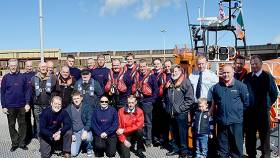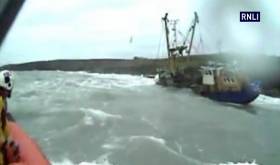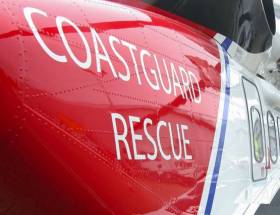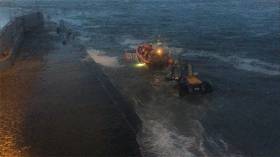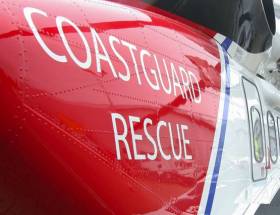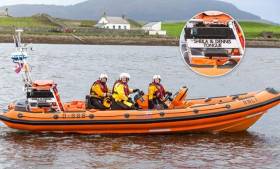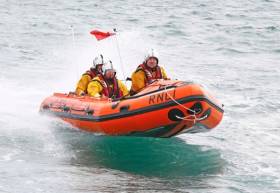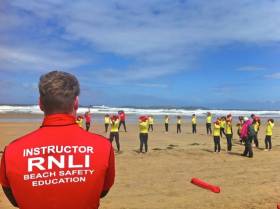Displaying items by tag: RNLI
Lifeboat crew past and present, family, fundraisers and well-wishers galore all gathered this weekend to wish one of Rosslare RNLI’s most well-known and respected lifeboat men, a long and happy retirement. Tony Kehoe spent 42 years volunteering with the RNLI as well as working as a fleet mechanic for the charity for a decade.
In a day filled with emotion Tony was taken out on a final lifeboat exercise with his colleagues. The railings down to the lifeboat had been lined with banners and Tony’s family, including his wife Veronica, daughter Sonia, son Brian, son-in-law Kieran, daughter-in-law Louise and grandchildren Robyn, Hannah, Darragh, Joe and Harry were there to witness his final lifeboat exercise. On returning to shore after the short trip, which brought them out past Tuskar Rock, members and supporters of Rosslare RNLI lined the walkway back to the lifeboat station and Tony shook everyone’s hand to receive congratulations and good wishes for a well-deserved retirement.
A reception was held later that evening at Culletons in Kilrane where family, friends and lifeboat people gathered to pay tribute. RNLI Divisional Operations Manager Owen Medland presented Tony with his RNLI Certificate of Service, which detailed every position Tony had held in the charity, including the many years he acted as second mechanic. Rosslare RNLI Deputy Launching Authority and Lifeboat Press Officer Jamie Ryan was the evening’s MC and speakers on the night included Rosslare RNLI Lifeboat Operations Manager David Maloney, Coxswain Eamon O’Rourke and representatives from the flanking lifeboat stations Kilmore Quay and Wexford RNLI with both Lifeboat Operations Manager Joe Maddock and Lifeboat Helm David Maguire paying their own tributes to Tony. Well known Rosslare resident Larry Dunne wrote a poem especially for the occasion.
Commenting on Tony’s retirement Rosslare Harbour RNLI Lifeboat Operations Manager David Maloney said, ‘We wanted to mark this event properly as Tony has been such an important person in Rosslare RNLI. He is a lifeboat man through and through and while he was never afraid to tell it like it is, he always had the interests of the crew and the lifeboat at his heart. He is one of the first people you would want on the lifeboat on a bad night and we have all benefitted from his advice and counsel over the years. I know we are not losing that and Tony will be a regular and welcome visitor to our door.’
It was Tony’s friendship with former Rosslare RNLI mechanic Matt Wickham that brought him onto the lifeboat back in 1974. His great uncle was Coxswain on the lifeboat for several years and he was born and reared beside the watchbox in Rosslare Port.
Tony reminisced about the changes that had occurred in the RNLI over the past forty years including that now, thankfully, there is a full kit for every crewmember on the lifeboat. Tony said, ‘ Back when I first joined there was one set of kit for the crew who went out on the lifeboat and whoever got there first got the best pair of boots and if you took a big pair of boats and a bigger fella came after you, that was it. There were no pagers so if you didn’t hear the maroon go off someone rapped on your door and off you went.’
Asked about the callouts during his time on the lifeboat crew, Tony said that the one that stood out in his memory was in 1978 with Coxswain Seamus McCormack, who received a bronze medal for the rescue of two fishing crew. Tony added, ‘It was to a Cornish fishing boat, Notre Dame du Sacre Coeur, she sank out there on a bad day. I was the youngest on that callout at just 22 years old. The crew had been trying to get into Milford Haven and a storm came on then and they lost power. During the night while they were adrift they had fired whatever distress signals they could. It was around noon that day when they were burning some stuff in a drum on the deck and a freighter spotted them and raised the alarm and we were launched.’
‘The freighter made a bit of a lee for us and we got a couple of men off it and the RAF helicopter took one man off. We took them off in very difficult seas. It was a bad day with a bad sea and an old lifeboat but everyone was saved and the crew all stayed in Rosslare that night and departed on the ferry the next day.’
Tony’s parting words of advice for his lifeboat crew as he enjoys his well-deserved retirement were short and to the point, ‘Mind yourselves and look out for one another.’
Kinsale RNLI Rescue Three Fishermen from Sinking Trawler (Video)
Three fishermen were rescued tonight (Sunday 10 April) in gale force conditions by volunteer lifeboat crew from Kinsale RNLI. The 20 metre beam trawler was forced onto the rocks at Moneypoint, at the entrance to Kinsale harbour, around 1800hrs this evening. See Video below.
Kinsale RNLI was launched at 6.10pm and arrived on scene less than five minutes later to find the vessel on the rocks with three-metre high waves breaking over its deck. The experienced lifeboat crew, led by Helm Nick Searls, dropped anchor and veered down, getting within feet of the stricken boat. The three crewmen then entered the water individually and were pulled to safety on board the RNLI lifeboat.
They were brought to Kinsale RNLI station where they were shaken by their ordeal but uninjured. The RNLI lifeboat returned to the scene to monitor the vessel and to ensure the safety of members of the public who lined the shore to watch the incident unfold. With the arrival of the local Coast Guard on the shoreline, the RNLI lifeboat returned to the station.
Kinsale RNLI Helm Nick Searls said: ‘Our priority was to get the crew safely off the trawler, which was complicated by the breaking waves coming over the top of the boat. We needed to manoeuvre the lifeboat in as close as possible to the stricken trawler so that the three fishermen could individually jump into the water to be recovered immediately by the lifeboat crew. The fishermen were wearing lifejackets and the operation to recover all three of them onto the lifeboat was successful.’
The three rescued men lost all their personal belongings and RNLI volunteers issued an appeal to the local community in Kinsale for clothing and shoes for the men. The station also received several offers of accommodation.
#Search - Two bodies have been found in the search for the missing crew of a fishing vessel that sank off Scotland's Western Isles early yesterday (Saturday 9 April).
One crew member was taken to hospital by helicopter as UK Coastguard teams from Stornaway and Prestwick joined the Barra RNLI lifeboat, local fishing vessels and Police Scotland in the search and rescue operation for three missing crewmates, as previously reported on Afloat.ie.
One fisherman remains missing after two bodies were recovered yesterday afternoon off Mingulay. Next of kin are aware and police officers are in contact with the families.
Mark Rodaway, national maritime operations commander for the UK Coastguard, said: “Despite an intensive search including the helicopters, lifeboat and other fishing vessels in the area, we have been unable to locate the missing fisherman. Our thoughts are with all those involved.”
Chief Inspector Alastair Garrow of Police Scotland said: "At this time we can confirm that the bodies of two men have been recovered. A third man was rescued and was taken to hospital at Stornoway. He is not seriously injured.
"A fourth man was on the boat and is still missing. The next of kin of all the men have been informed.
Chief Insp Garrow added: "An investigation will be carried out in parallel with the police and the Marine Accident and Investigation Branch (MAIB) and a report will be submitted to the Procurator Fiscal.
"This has been a tragic incident which will impact on the local community. Our thoughts are with the families affected."
The search has now been scaled back pending further information.
Bundoran RNLI Lifeboat Called To Surfers in Difficulty
The volunteer crew of Bundoran RNLI lifeboat were requested to launch yesterday evening (Saturday 9th April) to reports of surfers in difficulty off Tullaghan in County Leitrim. The 999 call was made by a member of the public who noticed the surfers struggling to make their way back to shore.
Within minutes the lifeboat launched in challenging conditions and made its way to the scene where the Sligo based Rescue 118 helicopter, who were returning from another incident, had already lifted one of the surfers out of the water. The other surfer was then lifted from the water by the lifeboat. The helicopter landed and handed over the surfer they had lifted to RNLI shore crew. Neither surfer needed medical assistance.
On their return to the the lifeboat station helm Brian Gillespie said 'the surfers had luck on their side with the helicopter passing and our boat being able to launch in such challenging conditions. The outcome was positive on this occasion and we are thankful we were able to get to the surfers on time. We would like to remind anyone who sees anyone in trouble on the coast to ring 999 or 112 and ask for the Coast Guard.
#RNLI - Bangor RNLI’s volunteer lifeboat crew launched at 7pm on Tuesday evening (5 April) to help in the rescue of a yacht whose engine had failed on passage from Stranraer to Bangor on Belfast Lough.
Bangor RNLI’s lifeboat operations manager Kevin Byers was first made aware of the situation by Belfast Coastguard at 5pm when the yacht was 15 miles northeast of Bangor, and knew that it had been taken in tow by the inbound fishing trawler Aurelia.
As the Aurelia was too large to bring the yacht all the way in to Bangor Marina, the Bangor lifeboat was launched just after 7pm to complete the rescue.
The yacht, with two adults and two children on board, was under power as there was little wind and the sea was calm. Unfortunately, the engine stopped and they were being carried by the tide.
Bangor RNLI's volunteer helm Gareth Whan said later: “This was a great example of good teamwork. Luckily, the Aurelia was able to bring the yacht most of the way, and we were able to complete the job, bringing it safely into Bangor Marina.
“Unfortunately, regardless of your preparation, engines can break down, and the lifeboat crew were all delighted to bring this group of people safely ashore."
#Search - One crew member from a fishing vessel has been rescued as the search continues for three others after the boat sank off Scotland's Western Isles in the early hours of this morning (Saturday 9 April).
The UK Coastguard received a distress alert just before 3:45am when the fishing vessel with four crew on board has its emergency positioning beacon (EPIRB) activated near Mingulay.
The coastguard search and rescue helicopter based at Stornoway has since been searching the area along with the Barra RNLI lifeboat.
One crew member has been taken to hospital by the helicopter. The lifeboat remains in the area and the coastguard helicopter from Prestwick has taken over so the search can continue.
#RNLI - The new Sligo Bay RNLI Atlantic 85 lifeboat is to be officially named Sheila & Dennis Tongue during a ceremony at the lifeboat station at Rosses Point in Sligo next Saturday 16 April 2016 at 3pm.
The lifeboat will be passed into the care of the RNLI and officially named during a short ceremony and service of dedication by brothers Raymond and Philip Tongue, who are nephews of the couple and will travel to Ireland with their families for the special event.
Mr and Mrs Dennis Tongue left a generous legacy to the RNLI in recognition of the vital life-saving work of the charity and as a thank-you for the happy days they spent living on the coast at Exmouth.
The couple were born in Birmingham in the 1920s and on Dennis’s retirement they moved to Devon where they lived until their eighties, overlooking the coast.
The couple did not have any children and it was during their retirement that they came to know and admire the work of the RNLI and recognise its place in the life of the communities it served.
The new lifeboat that arrived in Sligo last November, as previously reported on Afloat.ie, replaces Elsinore, which during its 13 years on service launched 189 times and rescued 155 people.
Sligo Bay RNLI lifeboat operations manager Willie Murphy, who will be accepting the lifeboat into the care of the station from the Tongue family on behalf of the volunteers, said: "I would like to express our sincere gratitude to the late Mr and Mrs Tongue for their generous and life-saving gift.
"This lifeboat is the vessel that will carry our volunteer lifeboat crew out to sea to save lives and rescue people in difficulty and it will provide our volunteer lifeboat crew the opportunity to train and develop their skills to carry out that work.
"We look forward to welcoming the family of Sheila and Dennis to this beautiful part of the world and we hope this is the beginning of a wonderful friendship with them."
The Atlantic 85 lifeboat was built at a cost of €276,000 and was introduced into the RNLI fleet in 2005. It operates mostly in shallow waters close to the shore or cliffs, among rocks and caves. It is operational in conditions up to a Force 7 and the design accommodates four crew and multiple casualties.
The lifeboat has a top speed of 35 knots and has a manually operated righting mechanism with inversion proofed engines, meaning it can be righted after capsize and kept operational.
The boat is also capable of being beached in an emergency without sustaining damage to the engines. It carries a full suite of communication and electronic navigation aids.
Sligo Bay RNLI crew and management will put their new lifeboat on display to the general public on their station open day on Sunday 19 June.
#RNLI - Four local towns went head-to-head at a recent quiz night in a bid to raise funds for Fethard RNLI’s new inshore lifeboat appeal.
Some 62 tables took on the challenge in four venues in Fethard on-Sea, Duncannon, Campile and New Ross last Friday (1 April) to determine which village or town would take the ‘Don’t be a fool on April Fool’s Day’ crown.
The honours went to New Ross on the night, with the winning team represented by Luke Grennan, Dan Meaney, Pat Kenny and Denis North.
Speaking following the event, Fethard RNLI fundraising chair Oonagh Hearne said: "Around 248 people enjoyed a great family evening with 62 tables participating and helping us to raise €3,000 towards our new inshore lifeboat appeal.
"Thank you to everyone who supported the event including The Brandon House Hotel, Neville’s Bar, Dunphy’s Bar and the Strand Tavern. Thanks to everyone who took part, the companies who donated prizes and all who helped organise the event. The community spirit was incredible."
Fethard RNLI hopes to raise €65,000 in their 18-month fundraising appeal which will go towards the cost of a new D class lifeboat due to arrive at the station late next year.
#Lifeguards - RNLI lifeguards are hitting the surf again and bringing their popular beach safety programmes to school children and youth groups in Northern Ireland.
Hundreds of children have already been through the programmes and learned valuable and important advice to keep safe in the water and along the shore, in a fun and interactive way.
Last summer 345,027 people visited the 10 RNLI-lifeguarded beaches on the Causeway Coast and in Co Down. Of these people 27,043 entered the water while 9,975 took part in surfing or other water leisure actives such as body boarding and kite surfing.
The lifeguards responded to 182 incidents, coming to the aid of 218 people. As well as rescues carried out in the water, lifeguards also dealt with falls, first aid and lost children.
The RNLI lifeguarding season has already begun on five beaches along the Causeway Coast and this cover will be extended for the peak summer season from Saturday 25 June through to Sunday 4 September.
In the run up to this and before schools break up for the summer, the RNLI is encouraging primary schools and youth groups to sign-up for its two beach safety education programmes.
The ‘Meet the Lifeguards’ and ‘Hit the Surf’ programmes teach young people the importance of beach safety in a fun and practical way.’
‘Meet the Lifeguards’ is an interactive session where RNLI lifeguards visit a school or youth group and teach the children key safety advice that they then put to use when they visit a beach with family and friends.
Children learn what the different beach safety flags and signs mean, the safety of using inflatables, the dangers of 'tombstoning', sun safety and how to identify natural and man-made hazards in and around the water. They will also learn about body boarding and surfing safety and how to escape a rip current. Information on tides and waves is included in the session.
The ‘Hit the Surf’ programme, meanwhile, offers a unique opportunity for school children or youth groups to get practical lessons in lifesaving and beach safety at one of the 10 RNLI-lifeguarded beaches located on the North Coast and in Co Down, or inland for the first time on the shores of Lough Erne in Cp Fermanagh.
The two-and-a-half-hour session includes a lesson on staying safe at the beach and explains the role of the RNLI and its lifeguards. It is followed by a lifesaving lesson and learning surf-based skills while building the children’s confidence in the sea. They will also learn about local hazards and the beach environment.
For more information on how to book your school onto an RNLI education programme in Northern Ireland, contact RNLI lifeguard supervisor Jenny Thompson 077 8992 4563 or email [email protected]
Bundoran RNLI Lifeboat Called to Donegal Town
The volunteer crew of Bundoran RNLI were last night requested to launch by Malin Head Coast Guard to reports of a person in the water at the pier in Donegal Town.
Following a 999 call from some passers by, the lifeboat was paged just after 11.45pm and launched around 11:53pm, proceeding to Donegal Town. On arrival on scene at 12:15am the crew commenced a search of the pier area in coordination with the Sligo based Rescue 118 Helicopte, the Killybegs Coast Guard boat, Gardai, Fire Service and HSE Ambulance.
Shortly after 1am, a person was recovered from the water and handed over to the waiting ambulance crew on the pier but was sadly later pronounced dead.
The management and crew of Bundoran RNLI Lifeboat extend sympathies to familiy and friends of the deceased.





























